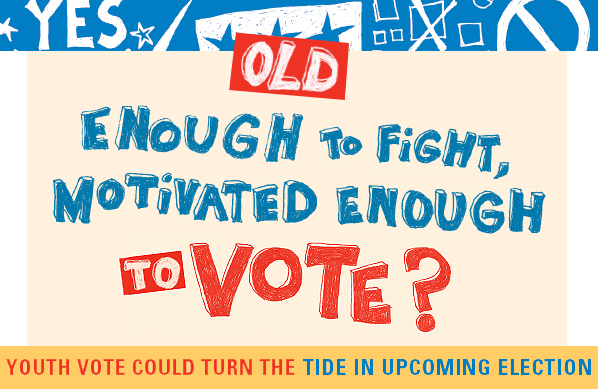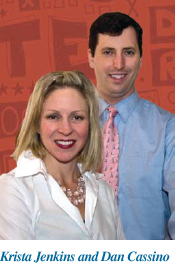

They could be drafted at 18, 19 and 20 and deployed to Vietnam but they were too young to vote. And so a movement took form. “Old enough to fight, old enough to vote” was the slogan heard across the nation as pressure grew in the late 1960s to lower the legal voting age from 21 to 18. The efforts proved successful. In 1971, the 26th Amendment to the U.S. Constitution was ratified, granting voting rights to millions of young citizens.
And yet, after gaining that right, youth participation steadily declined. In presidential election years between 1972 and 2000, for example, the turnout rate of young voters dropped 16 percent. And then came 2004, when, galvanized by a fiercely fought election between George Bush and John Kerry, many youth were drawn to the polls. More than 20 million 18-to-29-year-olds voted in the election, a significant increase from the 16.2 million who voted in 2000.
Was this a temporary spike or the beginning of a growing political role for the nation’s youth? If this year’s primary season was any indication, young citizens are determined to make their voices heard like never before. In New Hampshire, for example, the youth vote was twice as large as in 2004. In Iowa it was tripled. Other states reported similar results.
FDU Magazine asked two leading experts on youths in politics to discuss the growing enthusiasm of young citizens and the potential impact of the youth vote in the upcoming election.
FDU Magazine: This issue we have with us FDU faculty members Daniel Cassino and Krista Jenkins. Let us introduce them.

After receiving his doctorate in political science from Stony Brook University in New York, Dan Cassino was a staff researcher at Princeton University before coming to FDU. He is an assistant professor of political science at the College at Florham and the director of outside research for PublicMind™, FDU’s polling institute. His research focuses on political psychology, with an emphasis on how people perceive and evaluate political figures and parties. His forthcoming book, co-authored with his wife, Yasemin Besen-Cassino, is titled Consuming Politics: Jon Stewart, Symbolic Politics and the Youth Vote in America (Associated University Presses). The book examines why young people do not get involved in politics and concludes that they see politics as no different than other products and services that are marketed to them.
Krista Jenkins is an assistant professor of political science at Fairleigh Dickinson’s College at Florham and a survey analyst for PublicMind. She earned her PhD at Rutgers University, where she began work on a project that ultimately resulted in a co-authored book that examines generations and politics, titled A New Engagement? Political Participation, Civic Life, and the Changing American Citizen (Oxford University Press, 2006). The book challenges the idea that today’s youth are plagued by a severe case of political apathy. In addition to her research on youth and politics, Jenkins has studied gender and politics and is working on a book about mothers and daughters and their attitudes toward feminism and the women’s movement.
Let us start by asking whom are we specifically talking about when we refer to the youth vote? What distinctions exist among this demographic group?
Daniel Cassino: I’m specifically talking about 18-to-29-year-olds, and I would say that the main thing tying this group together is a way of perceiving political figures and parties as being no different than consumer products and brands. That isn’t to say that youth don’t have political views and affiliations, but that the processes and views underlying those views are very different from older cohorts.
Krista Jenkins: Generally, we’re speaking about those between the ages of 18 and 29, although sometimes people focus on the 18- to-24 group. But one needs to keep in mind that even though the tendency is to describe this cohort as if it is a monolith, the reality is it’s a pretty diverse group.
Are today’s youth different from older generations politically? If so, how and why?
KJ: Indeed they are different. They’re more independent and Democratic in their affiliation and tend to differ slightly from older cohorts on their attitudes toward certain social issues, such as gay rights and immigration. One likely reason for these differences has to do with how they’ve been socialized. They’re the most racially and ethnically diverse generation, and gays and lesbians have received far more acceptance today than when past generations were being socialized.
DC: In some ways, today’s young people are very similar to those in previous cohorts. For instance, partisanship among today’s young people is highly malleable, just as it’s been for the almost 50 years that political scientists have been studying partisanship. Today’s young Democrats may be tomorrow’s Republicans, and vice-versa.
Another thing we’re seeing is a large number of young people opting out of partisanship entirely, not being Democrats or Republicans. Now, that’s happened in the past, but it’s happening for different reasons now. For instance, in the late 1960s, so many young people were refusing to identify themselves as Republicans or Democrats that Gallup added a new category, “radical,” to categorize young people. So, they were opting out of normal partisan politics, but not because they didn’t appreciate or understand it: rather, because they were dealing with an entirely new set of issues and values. Moreover, there wasn’t much difference in political knowledge between younger and older cohorts then — nothing like the gaps in political knowledge or involvement that we see now.
My co-author and I argue that a lot of this comes from the way in which politics has been treated by the politicians themselves. Campaign consultants have been important to presidential politics since the 1840s, but it wasn’t until the late 1960s that they began to dominate the process. Politicians started selling themselves, their policies, their values, as if they were soap, and people who have grown up in that system, take them at their word.
What accounts for the sizable increase in youth participation in the 2008 primaries and caucuses? Is the surge coming from college campuses? What elements of the current youth interest are most striking to you?
KJ: Actually, the increase in youth participation is part of a larger trend that’s been going on for the past few elections. We’ve seen more young people turn out in the recent presidential elections, perhaps because of national issues that can potentially affect their demographic — such as the ongoing war in Iraq — as well as because of the apparent realization by some candidates that mobilizing the youth vote can indeed pay off.

As for what interests me the most, I’d say it’s the neglected story of continued youth apathy. That is, as much as the media likes to hype the youth turnout, the bigger story is continued young inactivism and the normalcy of NOT voting or doing anything political.
I’d argue that the hype is the result of the media’s tendency to report things that are “sexy” rather than substantive. It’s so much more novel to report on those who are bucking the trend rather than those who continue to opt out and their reasons for doing so.
DC: If you look at the first time young people register to vote, there’s been a substantial swing toward the Democratic Party. Starting around the mid-1980s, Republicans started to gain an advantage in those numbers, which slowed down by the late 1990s and picked up substantially after 9/11. The Iraq war, though, seemed to turn that advantage around, and by the end of 2003, more young people were registering as Democrats than as Republicans. If you look at just the period since 2005, Democrats have had a huge advantage — as much as 10:1 by some estimates.
Between Iraq and Katrina, there’s been an almost complete collapse of the Republican brand. Republicans used to be portrayed, and seen, as the serious, paternalistic party — now, youth-oriented media are making them look like buffoons. This has been a big advantage for Democrats, who have been able to identify themselves as the opposition party; and right now, that message resonates.
This is a very interesting time to be studying youth politics because it looks like we may be in the middle of what political scientists call a “rolling” or “replacement” realignment — the first one in American politics since the mid-1960s. That is, we have substantial numbers of young people belonging to a different party than their parents. Now, young people’s party identification is pretty unstable, but if young people stick with the Democrats into their 30s, when things start to stabilize, we could see a dramatic change in the long-term partisan balance favoring Democrats for 20 or 30 years to come.
FDU Magazine Home | Table of Contents | FDU Home | MyFDU.net | Blog About It
©Copyright 2008 Fairleigh Dickinson University. All rights reserved.
For a print copy of FDU Magazine, featuring this and other stories, contact Rebecca Maxon, editor,
201-692-7024 or maxon@fdu.edu.